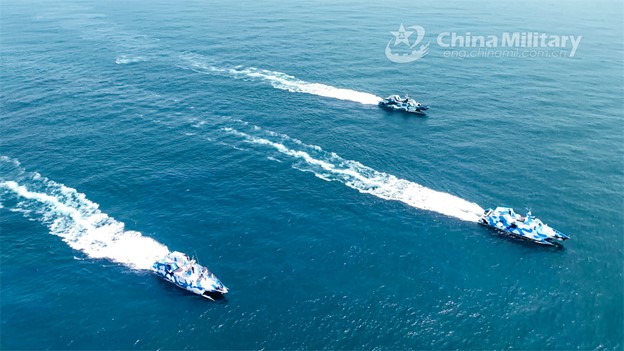Chinese ships, planes, and military personnel are congregating around Taiwan this week as Beijing launches one of its most aggressive military drills in recent years. Its goal is to increase pressure on the island’s newly inaugurated president, Lai Ching-Te. Each year China holds military drills from June to November. This year Beijing is ratcheting up pressure on Taiwan as well as effectively normalizing increased military activity in and around the island. “Hide and bide” is long dead and buried — it’s now “shout and flout.”
Chinese Coast Guard ships sailed within four nautical miles of Taiwanese waters near Kinmen Island four times this month and for the first time were joined by other Chinese government agencies. Kinmen is considered Taiwan’s strategic frontline island. China maintains three well-situated and supplied PLA Air bases as well along its coast opposite Taiwan with its maritime resources located nearby. According to Ian Ellis, a military analyst studying Chinese military strategy, “Throughout February, March, and April, Chinese Coast Guard vessels frequently entered Kinmen’s restricted waters and contiguous zone. On 29 April, Beijing announced it had ‘normalized’ regular patrols.”
Ray Powell, a maritime security analyst at the Gordian Knot Center for National Security Innovation at Stanford University, adds that China’s “open and heavily publicized characterization of its military exercises as ‘punishment’ and a ‘warning’ feels like a calculated rhetorical escalation. It wants the whole world to take note.” Since Lai assumed power this week, China “has launched two days of large-scale military drills surrounding Taiwan … days after the self-ruling island swore in a new democratically elected leader who called on Beijing to cease its intimidation tactics,” according to Shannon Brandao, an attorney who follows Chinese legal and military affairs. PLA Naval Colonel Li Xi, spokesperson for the command, called the exercises “a strong punishment for the separatist acts of Taiwan independence forces and a serious warning against interference and provocation by external forces.”
A CCN report on Thursday said a senior official responsible for Taiwan’s security affairs pointed out that the military detected about 30 Chinese aircraft, most of which crossed the Median Line into Taiwan’s air defense identification zone (ADIZ). China also deployed about a dozen Chinese warships and another dozen Coast Guard vessels near Taiwan’s outlying islands, according to the official. President Lai, who is labeled a “dangerous separatist” by Beijing, responded to the provocation by deploying Taiwan’s warships to monitor the situation. “While other countries treat maritime incidents as crises to be deescalated, Beijing seizes upon them as pretext for calculated escalations, by which it means to reset the board in its favor,” writes Ray Powell.
China’s state broadcaster CCTV is reporting that dozens of Chinese fighter jets carrying live ammunition conducted mock strikes against “high-value military targets” of the “enemy” alongside destroyers, frigates, and missile speedboats. To the north, two massive civil-military ferries that are part of the PLA-associated Bohai Ferry Group diverted from normal operating routes in the Yellow Sea and are heading south. The exercises, which started on Thursday, will encircle all of Taiwan and pose President Lai’s first challenge as he attempts to balance its relationship with Beijing. Chinese aggression is not limited to the waters around Taiwan. Last week China positioned five coast guard ships and six maritime militia vessels near the shoal belonging to the Philippines and had another 25 or so maritime militia vessels sitting roughly 60 miles further out, according to Powell.
As the number and intensity of incidents increases, so does the likelihood of an accident or deliberate act. The US operates about 200 ships and 150,000 sailors and civilians in its Pacific fleet. They make up 60 percent of the entire US Navy. Despite America’s advanced military technologies, Beijing has an advantage in a cross-Strait war with Taiwan. Its geographic location ensures short supply lines. The US Navy also is constraints by requirements that it patrol and protect wide swaths of the Pacific. This week the full Armed Services Committee in Congress is marking up the National Defense Authorization Act 2025 budget request. Even if Congress allots funding for additional ships and planes, it will be many years before they are operational in the Pacific. Beijing knows they have a window of opportunity that may not last long if President Biden is not re-elected. This year’s drills are more important than ever for Beijing.
Photo: Missile boats attached to a missile boat group with the navy under the PLA Southern Theater Command sail in formation. Photo by Wan Songtao)
